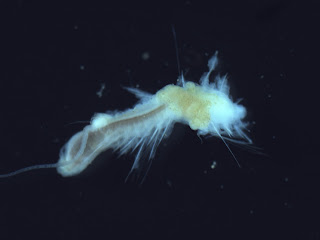Team Polychaete
The timing for this trip could not have been more perfect. Recently, my student, Kharis, has been working to identify small larvae collected on two expeditions in the Fram Strait. She's had her fair share of struggles with the process, including the realization that specimens she labeled as the same morphotype in the field are actually multiple different species. We're making it through the dataset - slowly. A challenge that's come up recently is that a number of her morphotypes don't match to any species in a public database. Our sequences are clean - but nobody has sequenced that particular species before. We have perfect data and no match. It's incredibly frustrating.
One particularly challenging group is the polychaetes, or segmented worms. Not many people in the world care about polychaetes (trust me, they should care), so it's an understudied group. Kharis asked a colleague for advice on who might have a lot of polychaete sequences we could use as a reference for our specimens, and one of the names he suggested stuck out to me: Nataliya Budaeva.
 |
| One of the Fram Strait polychaetes |
Conveniently, Natasha is now a professor at the University of Bergen, so I reached out to her as we were planning this trip. She remembered me right away and invited Kharis and me to come visit her at the university.
Our meeting was so incredibly productive. Natasha ran each of our polychaete sequences against her database and confirmed many of our identifications (thank goodness). For the ones we couldn't figure out, she had an absolute wealth of information to share. One specimen matched to a species in a public database, but Natasha told us it's a complex with multiple cryptic species - so she gave us a different name to use, pending publication of her own data. Two specimens in our study matched to the same genus, but she was able to tell us based on the sequences that they were two different species. For every case, she had a thorough, informative answer. What's more, Natasha donated pretty much her entire afternoon to helping us. It took us an hour to get through the data, and then she invited us to stay and share a coffee. I am so incredibly grateful for such a generous and knowledgeable collaborator.
 |
| Natasha's talk was at the natural history museum, so I strolled through their collection afterward. The diversity of specimens is incredibly impressive (here are some echinoderms). |
I actually figured out soon after arriving in Bergen that Natasha was scheduled to give a seminar on polychaete jaws this week, so I made sure to catch it. The presentation was geared for the general public, so it was actually a lot of fun. She ended up showing cartoon monsters inspired by polychaetes, sharing the origin of the term "bobbit worm," and teaching the audience how to catch polychaetes and their epitokes on the beach.
I am grateful for good collaborators and very glad I got to reconnect with Natasha. Until next time!
Comments
Post a Comment